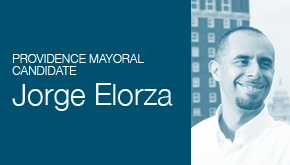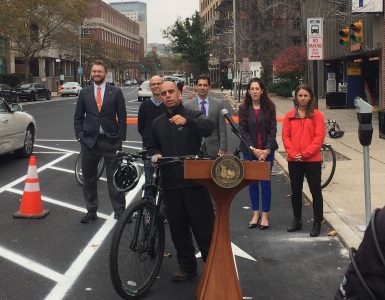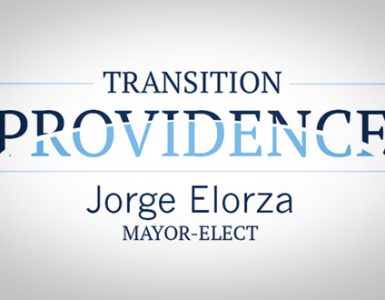Jorge Elorza, Democratic candidate for Mayor of Providence, issued the following statement on Providence Public School Department’s busing policy.
 Our city’s public high school students are not eligible for bus passes unless they live more than three miles from school. Students that fall into the far end of that range could be walking for as long as 45 minutes to an hour just to make it to their first period classes.
Our city’s public high school students are not eligible for bus passes unless they live more than three miles from school. Students that fall into the far end of that range could be walking for as long as 45 minutes to an hour just to make it to their first period classes.
As a community, we have to do everything in our power to make sure our students are in their classrooms and learning. Our students face too many challenges for us to be creating additional institutional barriers for them. Denying students who live between 2-3 miles away from school bus passes impacts learning, impacts health, and impacts safety, and our low-income communities are disproportionately affected.
When I was a child growing up on Cranston Street, my Mother acted as the school bus for many kids in the neighborhood. Although we were lucky to have her there to bring us to school, not every student is as lucky as we were.
Students and parents who recognize that this is an issue of fundamental fairness have been voicing their concerns and advocating to allow more students access to monthly bus passes since as early as 2009 in some cases. Community organizations such as Youth In Action, Young Voices, DARE, Providence Student Union (PSU), and other members of the Youth 4 Change Alliance have worked tirelessly to change these policies. As a candidate for Mayor, I stand with each of those individuals and organizations today.
Chronic absenteeism is a big problem in our city, and it’s a problem exacerbated by the fact that we ask our students to walk for so long, at such an early hour, often in frigid weather. When we compare Providence to other school districts, Providence schools show a uniquely strong correlation between cold weather and absenteeism. For example, Providence’s January-February daily absent percentage is more than double the percentage in May, whereas the disparity between January-February and May absences for schools in other cities is significantly less.
As Mayor, I will make bridging this gap a priority. Education was my path out of poverty. I would be nowhere today without the education I received and without all of the people I had advocating for me. Today, I want to advocate for our students. Today, I want to ensure that every Providence public high school student has the same opportunity to succeed that I did.
How can we fix this problem?
First, we need to dramatically decrease the minimum distance for students to receive bus passes. With a total city budget of $662 million, we must make it a priority to find the $1.35 million to fund passes for the 2,100 students who live between 2 and 3 miles from school. $1.35 million is only 0.2% of the total budget. This is a matter of priorities, not cash.
Providence should work with Rhode Island Public Transportation Authority (RIPTA) for a discount on bus passes for Providence public high school students. Reducing the cost from its current level of $62 per month will offset a portion of the additional $1.35 million. RISD and Brown University, which issue passes to their students and faculty, have negotiated with RIPTA so that they pay $1.15 per RIPTA ride as long as the number of rides exceeds 500,000 annually. My plan will add roughly 700,000 rides to the current total. If they can do it, so can we.
Second, we need to make our streets safer and more walking-friendly for those students remaining within 0-2 miles from their schools. This means everything from making sure that our signage and sidewalks are appropriate to making sure our drivers have the safety of our children at the forefront of their minds.
These solutions are all attainable, but they will only be implemented if we all work together to prioritize them, both by way of our words and our actions. Join me and walk with students from the Providence Student Union on February 24 at 6:30 am to help bring attention to this issue.
I am running for Mayor because our children should not have to walk an hour in the cold just to get to school and because I know an investment in education is an investment in health, safety, and happiness. I believe we are One Providence and that when part of our community suffers, we all suffer, and we all have shared responsibility for that suffering.
To learn more about the importance of transportation for students, or to tell me what #OneProvidence means to you, visit facebook.com/JorgeElorzaForMayor and connect with me on Twitter at @ElorzaForMayor.






Jorge Elorza’s position seems very reasonable. Though he was talking about high school students I regret the candidate did not use the opportunity to offer support for promoting “walking school buses” (see Jim Hummel report in current Motif) to elementary schools – in general students do not walk enough with resulting congestion around schools and rising obesity rates. He also missed an opportunity to note the need to ensure sidewalks are cleared of snow. In my town (No. Providence) most sidewalks arr still not cleared from last weeks storm so we need all the attention possible to this issue!
When I worked for an afterschool program, the cost of the school buses was phenomenal. The program had to plan everything around that cost, and there was only one monopolistic company that offered the services (which were often not performed very well). At the time, I had been talking with the program about creating more biking and walking like what Barry is talking about. I also think, at least for some schools, issuing RIPTA passes to students in middle-school and up would make more sense than expanding school bus services, since the routes the students need often overlap with the bus routes for adults, and would tend to help one another in terms of supporting frequency and span for users.
Also, I’m sorry to say I don’t agree that having students walk forty five minutes in the morning is going to cause them schooling problems. There’s a lot of evidence showing that activity deficits are a serious cause of learning problems like ADHD in classes, and that students who walk or bike to school have other cognitive advantages to driven or bused students in that they have to develop a sense of direction, which then can be applied to things like geometry.
I would give this statement an A+ for effort but overall a C- for thought.
45-minutes is a long walk twice a day, everyday, in snow, and freezing conditions. My walk is 20-minutes and sometimes I take the bus.
3 miles is also 3 miles as the crow files, not 3 miles as it is physically possible to walk.
So how do you feel about a student walking for 45-60 minutes to school when the temps are in the teens as they have been the past several mornings? Illness causes absence causes schooling problems. The students who have to walk the most are the most disadvantaged. This leads to students just skipping school.
Give high school students RIPTA passes. They have to walk to and from the bus stops, which are likely a lot closer than 3 miles. If I lived 3 miles from work in the most walkable neighborhood and it was flat, I wouldn’t consider walking.
And let’s be honest. 45 minutes is lowballing a 3 mile walk in the city when you take into account the hills, the book bags the students have to carry, and the fact that they have to cross streets. A 3 mile walk is probably a lot closer to an hour.
I’d rather we spent money on students than on some of the other things we spend money on.
“I’d rather we spent money on students than on some of the other things we spend money on.”
I think you both make good points, and maybe I’d moderate my position on this, but I’d like to emphasize that my objection has nothing to do with not wanting to spend money on students. My concern is that we should spend on them in a smart way.
I think for some sections of the city, expanding school buses may be the only way to go. The middle school I was at had a bus stop with a shelter at the foot of the school, and that bus was fairly infrequent for the hours I needed, but if the students had been given bus passes to use it, it would have totally changed the demand for that bus, and it would have benefited me as well as them.
Also, we really need to start thinking about biking for exactly this reason. The walk may be forty-five minutes, but the bike ride isn’t. I walk to work from a similar place as Jef to a relatively similar place, such that we bump elbows occasionally, and my walk is about 20 minutes. If I bike it takes me five, tops. But we can’t have large numbers of students biking to school until we abandon the sharrows and start making real improvements to actual bike infrastructure.
(Gosh, I feel like I am the curmudgeon in the comments section lately). 😉
Also, I want to add that I do really admire the thought that the Elorza campaign is putting into these issues even though I’m not sure I totally agree with this initiative, and I feel roughly the same about the Solomon and Smiley campaigns. I definitely see a lot of good efforts on this stuff. Elorza was one of the earliest signatures on our protected bike lane petition, so I don’t mean to set up a false dichotomy or say that their campaign doesn’t support those things. But there are first class priorities, and second class ones.
What about when your walk takes you through rival gang neighborhoods? What about when I’m disaffected and disconnected to school such that a 45 minute walk to school isn’t viewed as a healthy opportunity to get in some activity, work out my antsy feelings, and get to serious work, but instead is just one more reason not to go somewhere? What about when a 45 minute walk means waking up at 6am after working until 10pm and then doing homework the night before and I’m simply exhausted?
Let’s not turn speculation about what we might want in transit utopia into our education policy. Chronic absenteeism is absolutely massively harming all students in Providence right now. It is linked to all kinds of awful outcomes for individuals, and the peer effects of having a teacher constantly having to reteach is not sustainable. We are not tinkering in the margins– over half of Providence students are missing an entire month of school. It’s twice as big a problem here as it is in the suburbs where it’s already a huge problem. We need to remove ALL barriers for getting to and from school quickly and safely. When we talk to students this is constantly what they’re talking about. And of course, at the high school, we’re talking about using the exist transit infrastructure to supply the bussing. We’re talking RIPTA passes so these kids can get to school the same way they get to work and their family gets around the city right now.
“We need to remove ALL barriers for getting to and from school quickly and safely.”
Right, and what I’m saying is that this is not a cost effective way to do it, nor does it lead to the optimum conditions for learning, or for the health of communities, or the health of students, etc. Note, I didn’t say we should cut the buses for all students, or that we can’t form a flexible policy around having buses where they’re really needed, especially in cases where there are students who have special needs and so on (which would already be covered by an IEP). What I’m saying is that we should not have this become the blanket policy for the school district, because I know from personal on the ground experience in schools that this is a very expensive item. And I also know from on the ground experience in schools (here and in other cities) that schools now completely take away recess and gym in many cases in order to give more testing. So if you can build cycle tracks to get that kid that’s a forty-five minute walk from school to school in fifteen minutes on a bike, and have the buses there for kids at the periphery, or if you have a RIPTA pass available so that kids can at least make a choice between the two, you can start to get to some optimal mix.
Also, the rival gang territory example to me is pulling on heart strings without looking at causes. If you waste money on a program of busing for all students when you could optimize your spending on buses by letting some students use RIPTA and having many students bike or walk safely, then you’re not left with the money to deal with issues like violence. The buses are expensive enough that it really approaches a point where you could assign an adult to monitor biking and walking (as in the walking bus that Solomon has been tweeting about) and probably still save money.
I’m not saying this to put the idea of universal busing down. It’s a thoughtful idea. I just think it can be reworked to be a better idea.
Anyone who thinks 3 miles is a reasonable walk, go walk three miles in Providence right now. I’ll wait.
Yes, $1.35M dollars spent on RIPTA fares for high school students who are already more than 2 miles away from school is totally cost ineffective. Forget about the part of this where the proposal is to make the walk and biking environment better for that 0-2 mile distance, already further than kids anywhere else in the state have to walk and they don’t have a public transit system to use, but it’s clearly crazy to provide the option to take a free bus from 2 miles away (we pay per swipe).
Oh I see, your great idea is to pay adults to full time walk kids 30-40 mins in the winter each day in groups! That’s totally a great solution for getting high schoolers to show up who are telling us they are too tired, too cold, and too disinterested to walk in the first place! If there’s something disaffected 16 year old kids worried about crossing a rival neighborhood (this isn’t a heartstring, it’s a REAL concern kids bring up) loves its holding hands with adults and other kids who happen to live nearby! They love being infantilized.
Busses are great for people who may live along a streetcar route. But it’s totally cost ineffective and absurd to say kids 2 miles away from school in a district with more than 50% of kids missing one day every two weeks should be able to ride a bus for free to get to school. They should get on a bike because that’s healthier.
I’m not sure you know how to be anything but contrarian.
I just got back from walking the dog and was pretty miserable just doing a half mile circle around one of the best taken care of parts of all of Providence.
I’m working from home today.
Yeah, those kids should just suck it up or walk with the monitor.
James, read the statement again.
Elorza hasn’t even come close to suggesting more big yellow “school” buses. He’s suggested expanding the program to provide RIPTA bus passes to school children, which is cost effective and absolutely appropriate and absolutely necessary. It’s $1.35 million. Exactly how many miles of dedicated cycle track do you think we can buy on $1.35 million? I sure as hell doubt it’s nearly enough to cover all relevant sections of the city. Not even close.
I can understand your argument if and only if the proposal on the table is actual dedicated school buses. But it’s not. It’s bus passes to make the public transit in the city accessible to its high school student population. Expanding the bus pass program to students outside of a 2 mile radius, in all honesty, doesn’t go far enough. The radius should be 1/4 mile, not 2 miles; and the program should expand to middle schools as well as high schools. Even then, this program would be less than 1% of the budget.
If we can’t find the money or the political willpower to enable the city’s children to ride the bus to school, then the city has failed, and we have failed the city. If we can’t find a way to put our high school student body on the RIPTA buses that are running on our streets right now, then there’s absolutely no point in proposing to do anything else for families in Providence or urban culture.
We must do this, or everything else on the table to make it easier for families to move into the city is a worthless and pointless initiative. Full stop. Shooting this down means you’d rather have families fleeing the city for the suburbs the minute their kids are old enough for preschool – and I don’t think you actually want that.
Missing from this otherwise excellent conversation…
How about a look at why so many students travel so far? What happened to small. convenient neighborhood schools serving a walkable radius?
Well, Providence schools have been getting worse and worse. Parents who are not satisfied with their nearest school enroll their children is an ever increasing number of charter and magnet schools, all over the place. Who can blame them? If every neighborhood school was a good school few parents would bother to look elsewhere.
That, and any new school that gets built is usually on some brownfield off in the ass end of things.
“Elorza hasn’t even come close to suggesting more big yellow “school” buses. He’s suggested expanding the program to provide RIPTA bus passes to school children, which is cost effective and absolutely appropriate and absolutely necessary.”
Sorry, you’re right, I misunderstood the proposal. I think that expanding yellow buses is a horrible idea, and that giving out RIPTA passes is a great one. That’s my fault for not reading right.
“The radius should be 1/4 mile, not 2 miles; and the program should expand to middle schools as well as high schools.”
I guess I wouldn’t have any objections to this as a RIPTA pass program, but as a yellow bus program if that ever came about, this would be totally bat-shit crazy. As far as I’m concerned, providing totally free RIPTA service within the city for everyone would be fine with me, let alone for students. They do this for a few buses in Burlington, VT, and Tilinn, Estonia just did it for the whole city. I’m not totally convinced that free transit is the best thing we can do to get people to use the bus instead of driving (because the study of Tilinn seemed to suggest that people just walked less instead of driving less as the largest gain in the bus use) but I think it would be a great social justice initiative in a general sense.
Jason, as far as my having misunderstood the proposal, that’s egg on my face, but I really find your comments kind of unnecessarily combative, and I don’t think that they’re fair as far as they go. I wasn’t at all saying that I minded paying whatever cost it took to transport students, or suggesting that the kids were spoiled to be getting offered the service. I was saying that if the city stopped sitting on its hands and did things like create a viable bike network that’s workable for younger audiences and not just daring college students and thirty-somethings, that that would ultimately be of greater use to students than yellow buses (which, like I said, shows that I misread the statement). And Jef, the same. I specifically said that I thought we should work towards RIPTA passes and/or biking for students, not that they should tough it out and walk in the snow.
Just in general, as far as gang violence or snow go, I think both of these are bad reasons to have kids not walk. The answer to gang violence is gun control and investment in neighborhoods, and my point was that investing in an expensive band-aid like school buses would not help either. Essentially that would be providing Fortress Bus, which is slightly better than Fortress Car, but at the end of the day leaves kids locked in their classrooms/locked in their bus/locked in their car/locked in their house which is not the life we should aspire to for students. As far as looking into how many students are on yellow buses, I hope this RIPTA pass proposal reduces their numbers, because I think that would tend to help with the budgetary needs of the schools (not to give tax cuts, but to apply the money elsewhere in the school budget).
As a point of fact, I was under the impression that high school students already got the RIPTA passes, but that middle schoolers did not. Is that totally incorrect?
Here’s a link to an example of what I think can be done to make a horrible neighborhood where kids are unwelcome a good place to live (keep in mind this is 1970s in the Netherlands, so it’s hard to watch it as an American without imposing a toe-headed blond white kid’s privileges onto the situation, but I guess that these kids are what poverty looked like in 1970s Europe, and we can certainly make the same steps forward in our own neighborhoods with our own legacies of inequality).
http://bicycledutch.wordpress.com/2013/12/12/amsterdam-children-fighting-cars-in-1972/
Andrew,
You’re point about neighborhood schools is right on! That’s one of the things I’ve been saying about proposed spending on things like the Garrahy Parking. We’ve got some really nice, fixed-up schools that have decent amenities, and then we’ve got a bunch of really awful school buildings that are falling apart. If I recall, the Statehouse parking lot (just the one on Francis Street, not the one they tore the lawn up for) would amount to 80 teachers’ starting salaries (although minus benefits). There’s a lot we could do to restore good schooling so that kids don’t have to get into a lottery to go to a far away school they can’t travel to.
Gang violence and snow should not be reasons to not have kids walk, but the reality is that they are. In an ideal world, all the sidewalks would be perfectly clear of snow and ice and gangs wouldn’t exist and all children would have proper outerwear to handle cold New England winters. But this isn’t an ideal world and we need to get kids to school (the more they go to school, the less likely they are to get involved in gang activity, so you could argue that this is actually a solution to the gang problem). And snow isn’t even the main issue when it comes to the winter. It’s the cold. You try walking for 45 minutes when it’s 15° outside. Heck, try it when it’s 25° outside. It’s not a whole lot better. Add in a nice wind chill and you’ve got an awesome walk ahead of you. It’s not good for their health and it’s just another reason for them to say “Screw this, I’m staying home.” Snow and ice just make it that much less likely they’ll go for a nice 45 minute stroll (they’d probably be even less likely to want to bike in this weather).